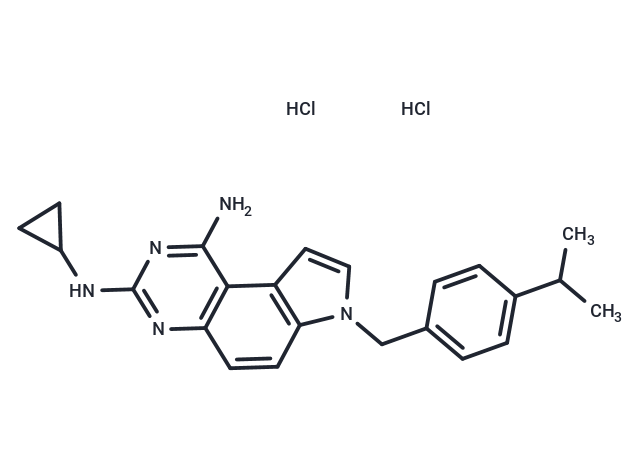Shopping Cart
- Remove All
 Your shopping cart is currently empty
Your shopping cart is currently empty


| Pack Size | Price | Availability | Quantity |
|---|---|---|---|
| 1 mg | $32 | In Stock | |
| 5 mg | $77 | In Stock | |
| 10 mg | $118 | In Stock | |
| 25 mg | $238 | In Stock | |
| 50 mg | $371 | In Stock | |
| 100 mg | $527 | In Stock |
| Description | SCH79797 dihydrochloride is an effective and selective antagonist of protease activated receptor 1 (PAR1) with an IC50 of 70 nM and a Ki of 35 nM. SCH79797 dihydrochloride has antiproliferative and pro-apoptotic effects. |
| In vitro | SCH79797 dihydrochloride inhibits thrombin-induced platelet aggregation with an IC50 of 3 μM. In NIH 3T3 cells, SCH79797 dihydrochloride inhibits serum-stimulated activation of p44/p42 mitogen-activated protein kinases (MAPK) at low concentrations and induces apoptosis at higher concentrations[1]. SCH79797 dihydrochloride inhibits high-affinity thrombin receptor-activating peptide ([3H]haTRAP) binding in a competitive manner. SCH79797 dihydrochloride inhibits α-thrombin- and haTRAP-induced aggregation of human platelets. Thrombin produces transient increases in cytosolic free Ca2+ concentration ([Ca2+]i) in hCASMC. SCH79797 dihydrochloride effectively inhibits this increase in [Ca2+]i. SCH79797 dihydrochloride completely inhibits Thrombin- and TK-stimulated [3H]thymidine incorporation [4]. |
| In vivo | In male Sprague Dawley rats, SCH79797 dihydrochloride (2.5 μg/kg, 10 μg/kg, 25 μg/kg, 50 μg/kg, 100 μg/kg, and 250 μg/kg; i.v.) reduces myocardial necrosis following I/R in the intact rat heart in two rat models of myocardial ischemia/reperfusion (I/R) injury immediately before or during ischemia[3]. |
| Molecular Weight | 444.4 |
| Formula | C23H27Cl2N5 |
| Cas No. | 1216720-69-2 |
| Storage | Powder: -20°C for 3 years | In solvent: -80°C for 1 year | Shipping with blue ice. | |||||||||||||||||||||||||
| Solubility Information | Ethanol: 10 mg/mL (22.50 mM), Sonication and heating are recommended. DMSO: 20 mg/mL (45.00 mM), Sonication and heating are recommended. | |||||||||||||||||||||||||
Solution Preparation Table | ||||||||||||||||||||||||||
Ethanol/DMSO
| ||||||||||||||||||||||||||

Copyright © 2015-2024 TargetMol Chemicals Inc. All Rights Reserved.